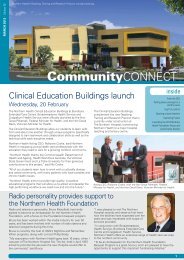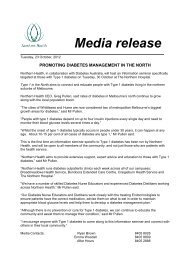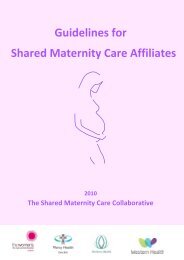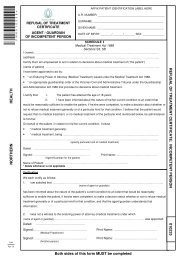Research Week Abstract Book - Northern Health
Research Week Abstract Book - Northern Health
Research Week Abstract Book - Northern Health
You also want an ePaper? Increase the reach of your titles
YUMPU automatically turns print PDFs into web optimized ePapers that Google loves.
Chronic Disease Management<br />
PRESCRIBING EVIDENCE-baseD MEDICINE IN HEART FAILURE: A PhysiCian-<br />
TARGETED INTERVENTION<br />
Chua C, Hutchinson A, Tacey M, Lim K, Aboltins C.<br />
Background<br />
Exacerbation of heart failure is a major cause of hospitalisation and readmissions worldwide. Despite strong evidence<br />
recommending the use of beta-blockers and angiotensin-converting enzyme inhibitors (ACEi) or angiotensin receptor<br />
blockers (ARB) in chronic heart failure management, these medications have been under-utilised.<br />
Aim<br />
To evaluate the effectiveness of a quality improvement initiative targeted at physicians on prescription of beta-blockers and<br />
ACEi/ARB for heart failure management in a hospital setting.<br />
Methodology<br />
A prospective audit of medical records was conducted at The <strong>Northern</strong> Hospital between January 2009 and April 2012.<br />
Data regarding the use of beta-blockers and ACEi/ARB were randomly collected from approximately 10% of patients<br />
discharged every month from each general medical and aged care unit with a primary diagnosis of heart failure. A two-staged<br />
intervention was carried out. From November 2009 to December 2010, a heart failure management protocol was established<br />
and presented during Grand Rounds and junior doctor education sessions. The second stage commenced in February 2011<br />
and consist of three-monthly feedback meetings for each participating medical unit.<br />
Results<br />
A significant rise in the prescription rates for both beta-blockers (p=0.014) and ACEi/ARB (p=0.002) was identified in the<br />
first six months. However no further significant changes were seen during the remaining period of the initial intervention. The<br />
second stage of the intervention resulted in a significant upward trend for ACEi/ARB prescription rates (p

















